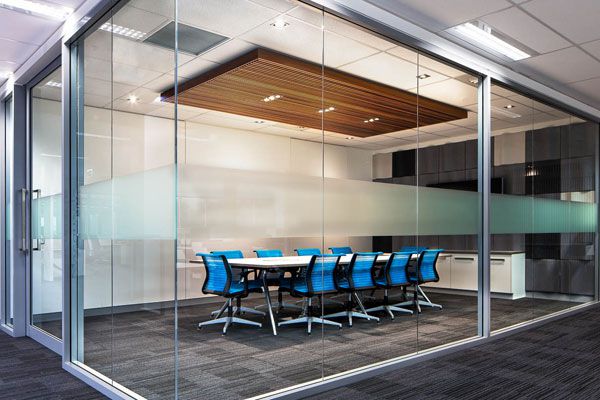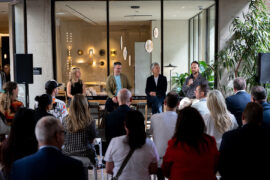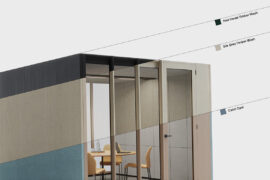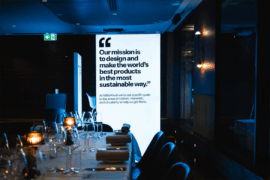The director of Seoul’s International Design Trend Center talks about the success and challenges facing Korean design today.
September 6th, 2011
“Korean design is truly emerging not only in Asia but also internationally,” says Prof Ken Nah.
“The advent of digital technology, the government’s efforts to promote design and the success of the business sectors have made Korean design competent in the global arena.”

Smart Pebble by young South Korean studio DesignMAXX
Prof Nah was recently in Singapore to judge the international red dot award: design concept (also see our interview with red dot judge Song Kee Hong).
Besides his role as director of the International Design Trend Center in Seoul, Prof Nah teaches design research and management at Hongik University’s International Design School for Advanced Studies.
“Generally speaking, the Korean designers, I think, are outstanding in the emotional aspects of design. However, they need to be more logical and fluent in communicating with people from other disciplines, such as marketing and business, technology and engineering, and the decision makers,” says Prof Nah.
“That is why I have taught courses on design research focussed on reading papers and on qualitative research through which they can improve the empathy and the skill of synthesis.”

Tea diver by young Seoul-based studio Abel and Partners has been a hit worldwide
Apart from research, Prof Nah feels that design management is fundamentally important and “a must for designers” moving forward.
“The purpose of design management is two-fold. Firstly, it is important for the CEOs to understand the potential and value of design and design thinking. Once the CEOs are in favour of design, they could do a lot more things than expected. I think this is the most effective way of increasing the value of design in the business sectors.
“The other is that the designers and design students have to understand the management and the context of business, because design is different from art, ” says Prof Nah.

WDC Seoul 2010
He candidly admits that ’Korean design’ is difficult to define as it focuses on reaching out to the international market. “The best examples we have are TVs, mobile phones and cars,” he says.
“We cannot survive with just the domestic market only.”

Seoul Design Assets exhibition
Academically, though, he feels that there have been several approaches to identify Korean design.
“I think one of the best examples was Seoul Design Asset, a project executed during WDC Seoul 2010,” says Prof Nah, who also served as director general for WDC.

Seoul Design Assets exhibition
Seoul was only the second city after Torino, Italy to win the WDC or World Design Capital bid.
During its 1-year term, each titled city is tasked to champion design as a means to improve social, cultural and economic aspects of life for its citizens through a host of initiatives and to demonstrate its design leadership.
One of many programmes held during the year-long campaign, Seoul Design Asset presented 600 years of design history via high-tech multimedia technologies to rediscover and reevaluate the traditions and values of Seoul design.
“I think Korean design is very unique in terms of quality and quantity as well. Every year, about 25,000 (good) designers come out of schools, which is 2nd next to the USA,” says Prof Nah.
“We also have a good collaborative system among government, business, and education… In a nutshell, our uniqueness stems from the team spirit of all stakeholders in design.”
INDESIGN is on instagram
Follow @indesignlive
A searchable and comprehensive guide for specifying leading products and their suppliers
Keep up to date with the latest and greatest from our industry BFF's!
The new range features slabs with warm, earthy palettes that lend a sense of organic luxury to every space.

Welcomed to the Australian design scene in 2024, Kokuyo is set to redefine collaboration, bringing its unique blend of colour and function to individuals and corporations, designed to be used Any Way!

The undeniable thread connecting Herman Miller and Knoll’s design legacies across the decades now finds its profound physical embodiment at MillerKnoll’s new Design Yard Archives.

For Aidan Mawhinney, the secret ingredient to Living Edge’s success “comes down to people, product and place.” As the brand celebrates a significant 25-year milestone, it’s that commitment to authentic, sustainable design – and the people behind it all – that continues to anchor its legacy.

In tribute to their incredible talent, body of work and inspirational professional journeys, four industry leaders have been honoured as our luminaries in the 2022 INDE.Awards.

Hughes Bruce Australia recently specified an assortment of Screenwood linear timber panels for various spaces at their project for DHL offices in Matraville.
The internet never sleeps! Here's the stuff you might have missed

Sub-Zero Wolf Kitchen Design Contest (KDC) announces the remarkable Arizona Biltmore as the location of the 2026 Gala Venue and Winners’ Summit

The CBD and South Melbourne Precinct promises a day of design experiences that balance movement, wellbeing, innovation and hospitality.

A new online space offers designers enhanced tools, resources and real-time customisation.

MillerKnoll reimagines the convention of dinner table interactions by plating up a future-forward menu of sustainable design conversation starters as part of the inspiring “Conversations for a Better World” event series.